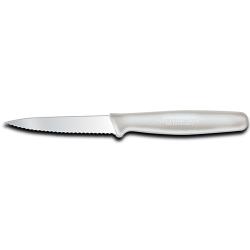Commercial Knives
- Kitchen Supplies
- Commercial Cutlery
- Commercial Knives
- Handle Color:White
- Serrated Blade:Yes
- Price:$5 - $10
Knives are to chefs like a paintbrush is to an artist—you wouln't cook or paint without your essentials, would you? Cutlery comes in all shapes and sizes to help you tackle the toughest of tasks. From breaking down animal carcasses to filleting a delicate fish, use the right knife for the job to attain the precision you're looking for. At Tundra Restaurant Supply we carry a diverse selection of commercial cutlery for your restaurant. Whether you're looking for a cleaver, cheese knife, or a trusty Chef's knife to add to your collection, you'll find exactly what you need. Curious to learn more about these knifes? Check out our Knives Buying Guide for more information.
Parts of a Knife
Most knives are constructed in one of two ways: stamped and forged. A stamped knife is literally "stamped" from a single piece of steel. This process is easy to execute on a mass scale which makes these knives reside at a more affordable price point. That said, some chefs take issue with the lightweight feel of a stamped knife and instead prefer forged knives, which is created by hand using a single piece of steel. These types of knives are often thicker and heavier because they're made by folding layers of steel over itself hundreds of time. You can quickly see if a knife is stamped or forged by the presence of a bolster, which is the raised, center part of the steel between the blade and the handle.
Ultimately there's no right or wrong answer when it comes to stamped versus forged knives—it's entirely up to the chef. For many chefs, the most important feature when it comes to knives is the ability to maintain an edge and retain the sharpness of the blade longer.
Commercial Knife Types
First thing's first when it comes to picking your knife—if you don't have a chef's knife yet, get one. The chef's knife can be used for virtually any task in the kitchen, and quite honestly, you will use it the most. When choosing a chef's knife, decide if you prefer a Western-style blade, which features 20° edge versus its Asian-style counterpart which has a 15° edge. Forged versus stamped chef's knives also come to play here, since some chefs prefer a heavier weight in their palm.
For those of you looking to butcher meats in-house, consider adding a meat saw, cleaver and boning knife to your inventory. Meat saws and cleavers are ideal for hacking through bone and breaking down large proteins. The boning knife on the other hand features a long, thin, flexible blade that enables you to cut flesh around the bone without tearing the fibers in the meat.
Other knives are useful for specific restaurant types and applications. For example, seafood restaurants wouldn't be without several oyster knives on hand. Similar to a paring knife, but featuring a stout, dull blade, oyster knives act as levers to pry open stubborn shells. Pizza restaurants on the other hand probably keep a drawer full of pizza knives to quickly slice up pies before delivering to customers.
How to Care for Your Knife
It should be no surprise that the best way to care for your cutlery is to keep it clean. The next step? Regularly hone and sharpen your knife. Contrary to popular belief, a sharpening or honing rod does not sharpen your knife. Rather, it helps bring your blade back to center. Sharpening on the other hand removes a small layer of steel from the knife to reveal a sharp edge. Sharpening your knives regularly will reduce its life, so only sharpen as necessary (maybe twice a year) and have a professional do the job.
The next secret to a longer life? Store your knives properly! Invest in knife block, magnetic strip or a knife bag to keep you knives safe and please, don't even consider just throwing knives into a knife drawer. Not only will your investment last longer, but you'll reduce the risk of any accidents.











